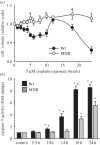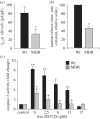Ion channels and transporters in the development of drug resistance in cancer cells
- PMID: 24493757
- PMCID: PMC3917363
- DOI: 10.1098/rstb.2013.0109
Ion channels and transporters in the development of drug resistance in cancer cells
Abstract
Multi-drug resistance (MDR) to chemotherapy is the major challenge in the treatment of cancer. MDR can develop by numerous mechanisms including decreased drug uptake, increased drug efflux and the failure to undergo drug-induced apoptosis. Evasion of drug-induced apoptosis through modulation of ion transporters is the main focus of this paper and we demonstrate how pro-apoptotic ion channels are downregulated, while anti-apoptotic ion transporters are upregulated in MDR. We also discuss whether upregulation of ion transport proteins that are important for proliferation contribute to MDR. Finally, we discuss the possibility that the development of MDR involves sequential and localized upregulation of ion channels involved in proliferation and migration and a concomitant global and persistent downregulation of ion channels involved in apoptosis.
Keywords: apoptosis; cancer; drug resistance; ion channels in cancer; tumour proliferation.
Figures






Similar articles
-
Mechanisms of multidrug resistance in cancer.Methods Mol Biol. 2010;596:47-76. doi: 10.1007/978-1-60761-416-6_4. Methods Mol Biol. 2010. PMID: 19949920
-
Ion channels and apoptosis in cancer.Philos Trans R Soc Lond B Biol Sci. 2014 Feb 3;369(1638):20130104. doi: 10.1098/rstb.2013.0104. Print 2014 Mar 19. Philos Trans R Soc Lond B Biol Sci. 2014. PMID: 24493752 Free PMC article. Review.
-
Multidrug resistance: retrospect and prospects in anti-cancer drug treatment.Curr Med Chem. 2006;13(16):1859-76. doi: 10.2174/092986706777585077. Curr Med Chem. 2006. PMID: 16842198 Review.
-
Ion channels in the regulation of apoptosis.Biochim Biophys Acta. 2015 Oct;1848(10 Pt B):2532-46. doi: 10.1016/j.bbamem.2014.10.030. Epub 2014 Oct 27. Biochim Biophys Acta. 2015. PMID: 25450339 Review.
-
Ion channels in cancer: future perspectives and clinical potential.Philos Trans R Soc Lond B Biol Sci. 2014 Feb 3;369(1638):20130108. doi: 10.1098/rstb.2013.0108. Print 2014 Mar 19. Philos Trans R Soc Lond B Biol Sci. 2014. PMID: 24493756 Free PMC article. Review.
Cited by
-
Facilitating the Cellular Accumulation of Pt-Based Chemotherapeutic Drugs.Int J Mol Sci. 2018 Aug 1;19(8):2249. doi: 10.3390/ijms19082249. Int J Mol Sci. 2018. PMID: 30071606 Free PMC article. Review.
-
Wittig derivatization of sesquiterpenoid polygodial leads to cytostatic agents with activity against drug resistant cancer cells and capable of pyrrolylation of primary amines.Eur J Med Chem. 2015 Oct 20;103:226-37. doi: 10.1016/j.ejmech.2015.08.047. Epub 2015 Aug 29. Eur J Med Chem. 2015. PMID: 26360047 Free PMC article.
-
Somatic synonymous mutations in regulatory elements contribute to the genetic aetiology of melanoma.BMC Med Genomics. 2020 Apr 3;13(Suppl 5):43. doi: 10.1186/s12920-020-0685-2. BMC Med Genomics. 2020. PMID: 32241263 Free PMC article.
-
Investigating age‑induced differentially expressed genes and potential molecular mechanisms in osteosarcoma based on integrated bioinformatics analysis.Mol Med Rep. 2019 Apr;19(4):2729-2739. doi: 10.3892/mmr.2019.9912. Epub 2019 Jan 30. Mol Med Rep. 2019. PMID: 30720085 Free PMC article.
-
Delivery of therapeutic oligonucleotides in nanoscale.Bioact Mater. 2021 Jun 12;7:292-323. doi: 10.1016/j.bioactmat.2021.05.038. eCollection 2022 Jan. Bioact Mater. 2021. PMID: 34466734 Free PMC article. Review.
References
-
- Stavrovskaya AA. 2000. Cellular mechanisms of multidrug resistance of tumor cells. Biochemistry (Mosc). 65, 95–106. - PubMed
Publication types
MeSH terms
Substances
LinkOut - more resources
Full Text Sources
Other Literature Sources

